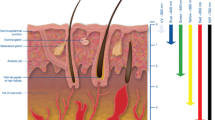Abstract
Information regarding the propagation media is typically gathered by conducting physical experiments, measuring and processing the corresponding data to obtain channel characteristics. When this propagation media is human body, for example in case of medical implants, then this approach might not be practical. In this paper, an immersive visualization environment is presented, which is used as a scientific instrument that gives us the ability to observe RF propagation from medical implants inside a human body. This virtual environment allows for more natural interaction between experts with different backgrounds, such as engineering and medical sciences. Here, we show how this platform has been used to determine channel models for medical implant communication systems.















Similar content being viewed by others
Notes
HFSS is registered trademark of ANSYS Inc. The HFSS has been used in this research to foster understanding. Such identification does not imply recommendation or endorsement by the National Institute of Standards and Technology, nor does it imply that this product is necessarily the best available for the purpose.
References
B. Chi, J. Yao, S. Han, X. Xie, G. Li, and Z. Wang, Lowpower transceiver analog front-end circuits for bidirectional high data rate wireless telemetry in medical endoscopy applications, IEEE Transaction Biomedical Engineering, Vol. 54, No. 7, pp. 1291–1299, 2007.
E. H. Sarraf, G. K. Wong, and K. Takahata, Frequency-selectable wireless actuation of hydrogel using micromachined resonant heaters toward implantable drug delivery applications. Solid-State Sensors, Actuators and Microsystems Conference, pp. 1525–1528. Denver, CO, USA, 21–25 June 2009.
K. H. Shin, C. Y. Moon, T. H. Lee, C. H. Lim, and Y. J. Kim, Implantable flexible wireless pressure sensor module, Sensors, 2004, Proceedings of IEEE Solid-State Sensors, Actuators and Microsystems Conference, Vol. 2, pp. 844–847. Seoul, Korea, 2004.
H. Fassbender, W. Mokwa, M. Gortz, K. Trieu, U. Urban, T. Schmitz-Rode, T. Gottsche, and P. Osypka, Fully implantable blood pressure sensor for hypertonic patients. IEEE Solid-State Sensors, Actuators and Microsystems Conference, pp. 1226–1229. IEEE, Piscataway, NJ, 2008.
J. L. Bohorquez, A. P. Chandrakasan, and J. L. Dawson, A 350 uW CMOS MSK Transmitter and 400 uW OOK super-regenerative receiver for medical implant communications, IEEE Journal of Solid-State Circuits, Vol. 44, No. 4, pp. 1248–1259, 2009.
J. Kwong, Y. K. Ramadass, N. Verma, and A. Chandrakasan, A 65 nm Sub-Vt microcontroller with integrated SRAM and switched capacitor DC-DC converter, IEEE Journal of Solid-State Circuits, Vol. 44, No. 1, pp. 115–126, 2009.
G. Yang, Body Sensor Networks, SpringerLondon, 2006. ISBN 1-84628-272-1.
W. Yang, K. Sayrafian-Pour, J. Hagedorn, J. Terrill, and K. Y. Yazdandoost, Simulation study of body surface RF propagation for UWB wearable medical sensors. Proceedings of the 2nd International Symposium on Applied Sciences in Biomedical and Communication Technologies, ISABEL, 2009.
J. G. Hagedorn, J. P. Dunkers, S. G. Satterfield, A. P. Peskin, J. T. Kelso, and J. E. Terrill, Measurement tools for the immersive visualization environment: steps toward the virtual laboratory. Journal of Research of the National Institute of Standard and Technology, Vol. 112, No. 5, pp. 257–270, 2007.
C. A. Balanis, Antenna Theory, Analysis and Design, vol. 2nd, John Wiley & Sons Inc.New York, 1997.
C. Polk and E. Postow, Biological Effects of Electromagnetic Fields, CRC Press, Inc.Boca Raton, 1996. ISBN 0-8493-0641-8.
G. S. Smith, A theoretical and experimental study of the insulated loop antenna in a dissipative medium, Radio Science, Vol. 8, pp. 711–725, 1973.
K. Y. Yazdandoost and R. Kohno, An antenna for medical implant communication systems. Proceedings of the 37th European Microwave Conference, Munich, Germany. Oct. 2007
K. Y. Yazdandoost and R. Kohno, Body implanted medical device communications. IEICE Transactions on Communications, Vol. E92-B, No. 2, pp. 2741–2749, 2009.
P. S. Hall and Y. Hao, Antennas and Propagation for Body Centric Wireless Communications, Artech House, Inc.Norwood, MA, 2006. ISBN 1-58053-493-7.
Acknowledgment
The authors would like to thank Mr. Steven Satterfield from the high performance computing and visualization group of the Applied and Computational Mathematics Division, ITL, for his assistance in the system setup and his ongoing contribution in the development of tools for the NIST immersive visualization system.
Author information
Authors and Affiliations
Corresponding author
Rights and permissions
About this article
Cite this article
Sayrafian-Pour, K., Yang, WB., Hagedorn, J. et al. Channel Models for Medical Implant Communication. Int J Wireless Inf Networks 17, 105–112 (2010). https://doi.org/10.1007/s10776-010-0124-y
Received:
Accepted:
Published:
Issue Date:
DOI: https://doi.org/10.1007/s10776-010-0124-y




